April Vegetation Dynamics and Forest–Climate Interactions in Central Appalachia
Abstract
1. Introduction
- Determine if there is a trend in vegetation change in the Appalachian Mountains region and, if so, at what spatial scale.
- Investigate whether the potential trend is significant and influences near-surface climate conditions.
- Identify the dominant biogeophysical process that is responsible for the possible changes in the near-surface climate conditions.
2. Data and Methods
2.1. Data
2.2. Methods
2.2.1. Linear Regression Analysis
2.2.2. Detrended Composite Analysis
2.2.3. Detrended Correlation Analysis
3. Results
3.1. NDVI Trends
3.2. Detrended Composite Difference Analysis
3.3. Detrended Correlation Analysis
3.4. Dryness Index Analysis
4. Discussion and Conclusions
- Determine if there is a trend in vegetation change in the Appalachian Mountains region and, if so, at what spatial scale.
- Investigate whether the potential trend is significant and influences near-surface climate conditions.
- Identify the dominant biogeophysical process that is responsible for the possible changes in the near-surface climate conditions.
- A statistically significant increasing trend in April vegetation existed from 1982 to 2015 in central Appalachia.
- There was empirical evidence that this increasing vegetation trend was significant and altered near-surface climatic conditions.
- We proposed that the dominant biogeophysical process responsible for the changes in near-surface climate conditions was the positive moisture feedback process.
Supplementary Materials
Author Contributions
Acknowledgments
Conflicts of Interest
References
- ARC. An Assessment of Natural Assets in the Appalachian Region: Forest Resources. Available online: https://www.arc.gov/assets/research_reports/AssessmentofNaturalAssetsintheAppalachianRegion-ForestResources.pdf (accessed on 20 May 2019).
- Nesbitt, J.T.; Weiner, D. Conflicting environmental imaginaries and the politics of nature in Central Appalachia. Geoforum 2001, 32, 333–349. [Google Scholar] [CrossRef]
- Foley, J.A.; DeFries, R.; Asner, G.P.; Barford, C.; Bonan, G.; Carpenter, S.R.; Chapin, F.S.; Coe, M.T.; Daily, G.C.; Gibbs, H.K. Global consequences of land use. Science 2005, 309, 570–574. [Google Scholar] [CrossRef] [PubMed]
- Pielke, R.A. Land use and climate change. Science 2005, 310, 1625–1626. [Google Scholar] [CrossRef] [PubMed]
- Appalachian Regional Commission, Subregions in Appalachia. 2009. Available online: https://www.arc.gov/research/mapsofappalachia.asp?MAP_ID=31 (accessed on 1 September 2019).
- Steyaert, L.T.; Knox, R.G. Reconstructed historical land cover and biophysical parameters for studies of land-atmosphere interactions within the eastern United States. J. Geophys. Res. Atmos. 2008, 113. [Google Scholar] [CrossRef]
- Pericak, A.A.; Thomas, C.J.; Kroodsma, D.A.; Wasson, M.F.; Ross, M.R.; Clinton, N.E.; Campagna, D.J.; Franklin, Y.; Bernhardt, E.S.; Amos, J.F. Mapping the yearly extent of surface coal mining in Central Appalachia using Landsat and Google Earth Engine. PLoS ONE 2018, 13, e0197758. [Google Scholar] [CrossRef]
- Simmons, J.A.; Currie, W.S.; Eshleman, K.N.; Kuers, K.; Monteleone, S.; Negley, T.L.; Pohlad, B.R.; Thomas, C.L. Forest to reclaimed mine land use change leads to altered ecosystem structure and function. Ecol. Appl. 2008, 18, 104–118. [Google Scholar] [CrossRef]
- Ross, M.R.; McGlynn, B.L.; Bernhardt, E.S. Deep impact: Effects of mountaintop mining on surface topography, bedrock structure, and downstream waters. Environ. Sci. Technol. 2016, 50, 2064–2074. [Google Scholar] [CrossRef]
- Foley, J.A.; Costa, M.H.; Delire, C.; Ramankutty, N.; Snyder, P. Green surprise? How terrestrial ecosystems could affect earth’s climate. Front. Ecol. Environ. 2003, 1, 38–44. [Google Scholar]
- Bonan, G.B. Forests and Climate Change: Forcings, Feedbacks, and the Climate Benefits of Forests. Science 2008, 320, 1444–1449. [Google Scholar] [CrossRef]
- Chase, T.N.; Peilke, R.A., Sr.; Kittel, T.G.F.; Nemani, R.R.; Running, S.W. Simulated impacts of historical land cover changes on global climate in northern winter. Clim. Dyn. 2000, 16, 93–105. [Google Scholar] [CrossRef]
- Pielke, R.A.; Pitman, A.; Niyogi, D.; Mahmood, R.; Mcalpine, C.; Hossain, F.; Goldewijk, K.K.; Nair, U.; Betts, R.; Fall, S.; et al. Land use/land cover changes and climate: Modeling analysis and observational evidence. WIREs Clim. Chang. 2011, 2, 828–850. [Google Scholar] [CrossRef]
- Pielke, R.A.; Avissar, R. Influence of landscape structure on local and regional climate. Landsc. Ecol. 1990, 4, 133–155. [Google Scholar] [CrossRef]
- Dirmeyer, P.A.; Niyogi, D.; De Noblet-Ducoudré, N.; Dickinson, R.E.; Snyder, P.K. Impacts of land use change on climate. Int. J. Climatol. 2010, 30, 1905–1907. [Google Scholar] [CrossRef]
- Mahmood, R.; Pielke, R.A.; Hubbard, K.G.; Niyogi, D.; Dirmeyer, P.A.; McAlpine, C.; Carleton, A.M.; Hale, R.; Gameda, S.; Beltrán-Przekurat, A. Land cover changes and their biogeophysical effects on climate. Int. J. Climatol. 2014, 34, 929–953. [Google Scholar] [CrossRef]
- Meehl, G.A. Influence of the land surface in the Asian summer monsoon: External conditions versus internal feedbacks. J. Clim. 1994, 7, 1033–1049. [Google Scholar] [CrossRef]
- Charney, J.G. Dynamics of deserts and drought in the Sahel. Q. J. R. Meteorol. Soc. 1975, 101, 193–202. [Google Scholar] [CrossRef]
- Xue, Y. Biosphere feedback on regional climate in tropical North Africa. Q. J. R. Meteorol. Soc. 1997, 123, 1483–1515. [Google Scholar] [CrossRef]
- Strack, J.E.; Pielke, R.A., Sr.; Steyaert, L.T.; Knox, R.G. Sensitivity of June near-surface temperatures and precipitation in the eastern United States to historical land cover changes since European settlement. Water Resour. Res. 2008, 44. [Google Scholar] [CrossRef]
- Koster, R.D.; Dirmeyer, P.A.; Guo, Z.; Bonan, G.; Chan, E.; Cox, P.; Gordan, C.T.; Kanae, S.; Kowalczyk, E.; Lawrence, D.; et al. Regions of Strong Coupling Between Soil Moisture and Precipitation. Science 2004, 305, 1138–1140. [Google Scholar] [CrossRef]
- Dirmeyer, P.A.; Gao, X.; Zhao, M.; Guo, Z.; Oki, T.; Hanasaki, N. The Second Global Soil Wetness Project (GSWP-2): Multi-model analysis and implications for our perception of the land surface. Bull. Am. Meteorol. Soc. 2006, 87, 1381–1397. [Google Scholar] [CrossRef]
- Shukla, J.; Mintz, Y. Influence of Land-Surface Evapotranspiration on the Earth’s Climate. Science 1982, 215, 1498–1501. [Google Scholar] [CrossRef] [PubMed]
- Lee, E.; He, Y.; Zhou, M.; Liang, J. Potential feedback of recent vegetation changes on summer rainfall in the Sahel. Phys. Geogr. 2015, 36, 449–470. [Google Scholar] [CrossRef]
- Lee, E.; Chase, T.N.; Rajagopalan, B.; Barry, R.G.; Biggs, T.W.; Lawrence, P.J. Effects of irrigation and vegetation activity on early Indian summer monsoon variability. Int. J. Climatol. 2009, 29, 573–581. [Google Scholar] [CrossRef]
- Yang, L.; Sun, G.; Zhi, L.; Zhao, J. Negative soil moisture-precipitation feedback in dry and wet regions. Sci. Rep. 2018, 8, 4026. [Google Scholar] [CrossRef] [PubMed]
- Shukla, J.; Nobre, C.; Sellers, P. Amazon Deforestation and Climate Change. Science 1990, 247, 1322–1325. [Google Scholar] [CrossRef]
- Snyder, P.K.; Delire, C.; Foley, J.A. Evaluating the influence of different vegetation biomes on the global climate. Clim. Dyn. 2004, 23, 279–302. [Google Scholar] [CrossRef]
- Tucker, C.J. Red and photographic infrared linear combinations for monitoring vegetation. Remote Sens. Environ. 1979, 8, 127–150. [Google Scholar] [CrossRef]
- Myneni, R.B.; Hall, F.G.; Sellers, P.J.; Marshak, A.L. The interpretation of spectral vegetation indexes. IEEE Trans. Geosci. Remote Sens. 1995, 33, 481–486. [Google Scholar] [CrossRef]
- Tucker, C.J.; Pinzon, J.E.; Brown, M.E.; Slayback, D.; Pak, E.; Mahoney, R.; El Saleous, N. An extended AVHRR 8-km NDVI dataset compatible with MODIS and SPOT vegetation NDVI data. Int. J. Remote Sens. 2005, 26, 4485–4498. [Google Scholar] [CrossRef]
- Mesinger, F.; Dimego, G.; Kalnay, E.; Mitchell, K.; Shafran, P.C.; Ebisuzaki, W.; Jović, D.; Woollen, J.; Rogers, E.; Berbery, E.H.; et al. North American Regional Reanalysis. Bull. Am. Meteorol. Soc. 2006, 87, 343–360. [Google Scholar] [CrossRef]
- Lee, E.; Bieda, R.; Shanmugasundaram, J.; Richter, H.B. Land surface and atmospheric conditions associated with heat waves over the Chickasaw Nation in the South Central United States. J. Geophys. Res. Atmos. 2016, 121, 6284–6298. [Google Scholar] [CrossRef]
- Abatzoglou, J.T. Development of gridded surface meteorological data for ecological applications and modelling. Int. J. Climatol. 2011, 33, 121–131. [Google Scholar] [CrossRef]
- Gaertner, B.A. Impacts of Climate and Land Cover on Water Balance Components in the Central Appalachian Mountains, USA. Ph.D. Thesis, Davis College of Agriculture, Natural Resources and Design, Morgantown, WV, USA, 2019. Available online: https://researchrepository.wvu.edu/etd/3931 (accessed on 5 June 2019).
- Mitchell, T.D.; Jones, P.D. An improved method of constructing a database of monthly climate observations and associated high-resolution grids. Int. J. Climatol. 2005, 25, 693–712. [Google Scholar] [CrossRef]
- Freund, R.J.; Wilson, W.J.; Sa, P. Regression Analysis: Statistical Modeling of a Response Variable, 2nd ed.; Academic Press: Burlington, MA, USA, 2006. [Google Scholar]
- Walpole, R.E.; Myers, R.H.; Myers, S.L.; Ye, K. Probability and Statistics for Engineers and Scientists; Macmillan: New York, NY, USA, 1993. [Google Scholar]
- Yue, X.; Unger, N.; Keenan, T.F.; Zhang, X.; Vogel, C.S. Probing the past 30 year phenology trend of US deciduous forests. Biogeosciences 2015, 12, 6037–6080. [Google Scholar] [CrossRef]
- White, M.A.; de Beurs, K.M.; Didan, K.; Inouye, D.W.; Richardson, A.D.; Jensen, O.P.; O’Keefe, J.; Zhang, G.; Nemani, R.R.; van Leeuwen, W.J.; et al. Intercomparison, interpretation, and assessment of spring phenology in North America estimated from remote sensing for 1982–2006. Glob. Chang. Biol. 2009, 15, 2335–2359. [Google Scholar] [CrossRef]
- Schwartz, M.D.; Crawford, T.M. Detecting energy-balance modifications at the onset of spring. Phys. Geogr. 2001, 22, 394–409. [Google Scholar] [CrossRef]
- United States Department of Agriculture Forest Service. Monongahela National Forest. Available online: https://www.fs.usda.gov/mnf/ (accessed on 18 October 2019).
- United States Department of Agriculture Forest Service. National Forests in North Carolina: Nantahala National Forest. Available online: https://www.fs.usda.gov/recarea/nfsnc/recarea/?recid=48634 (accessed on 18 October 2019).
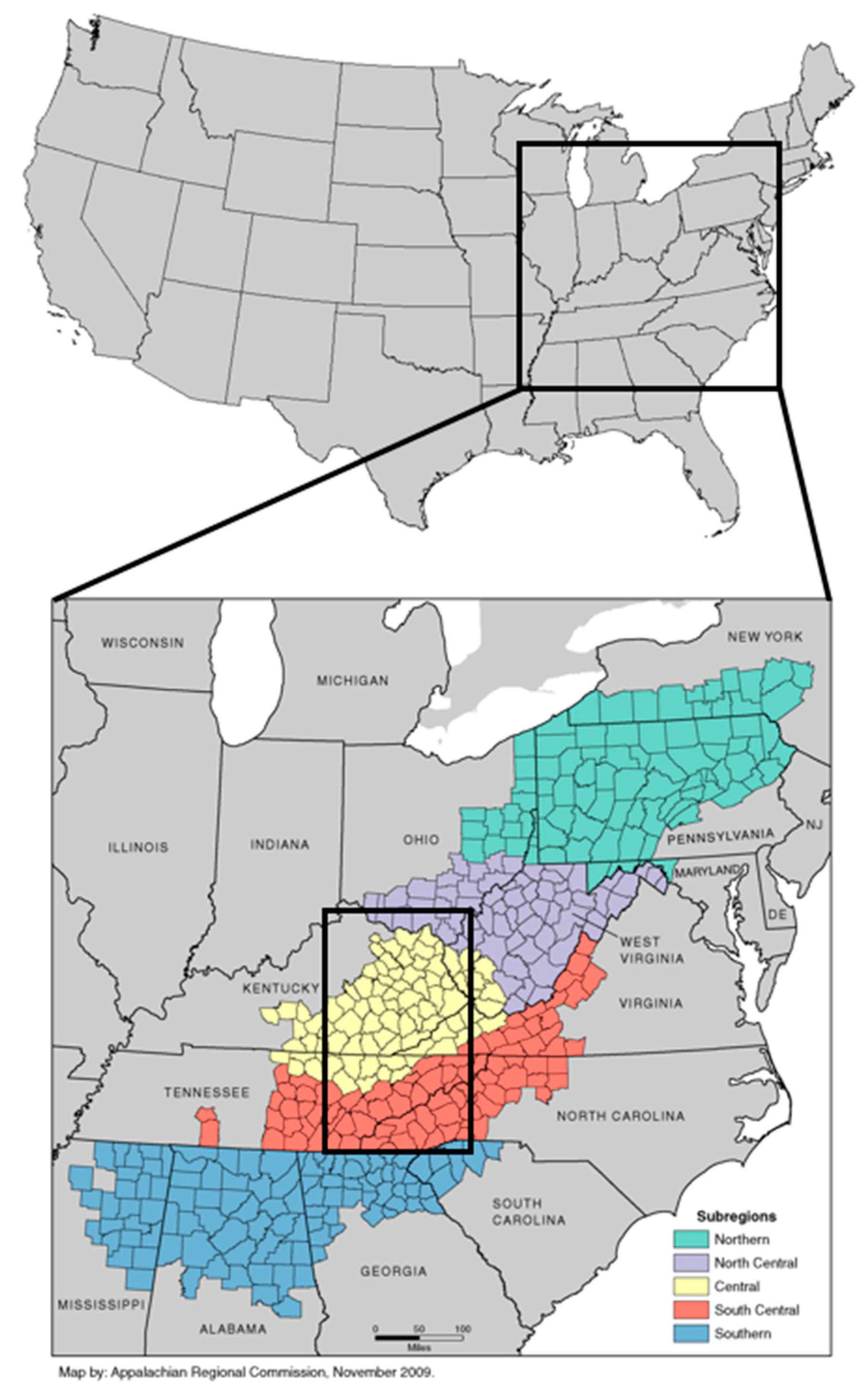
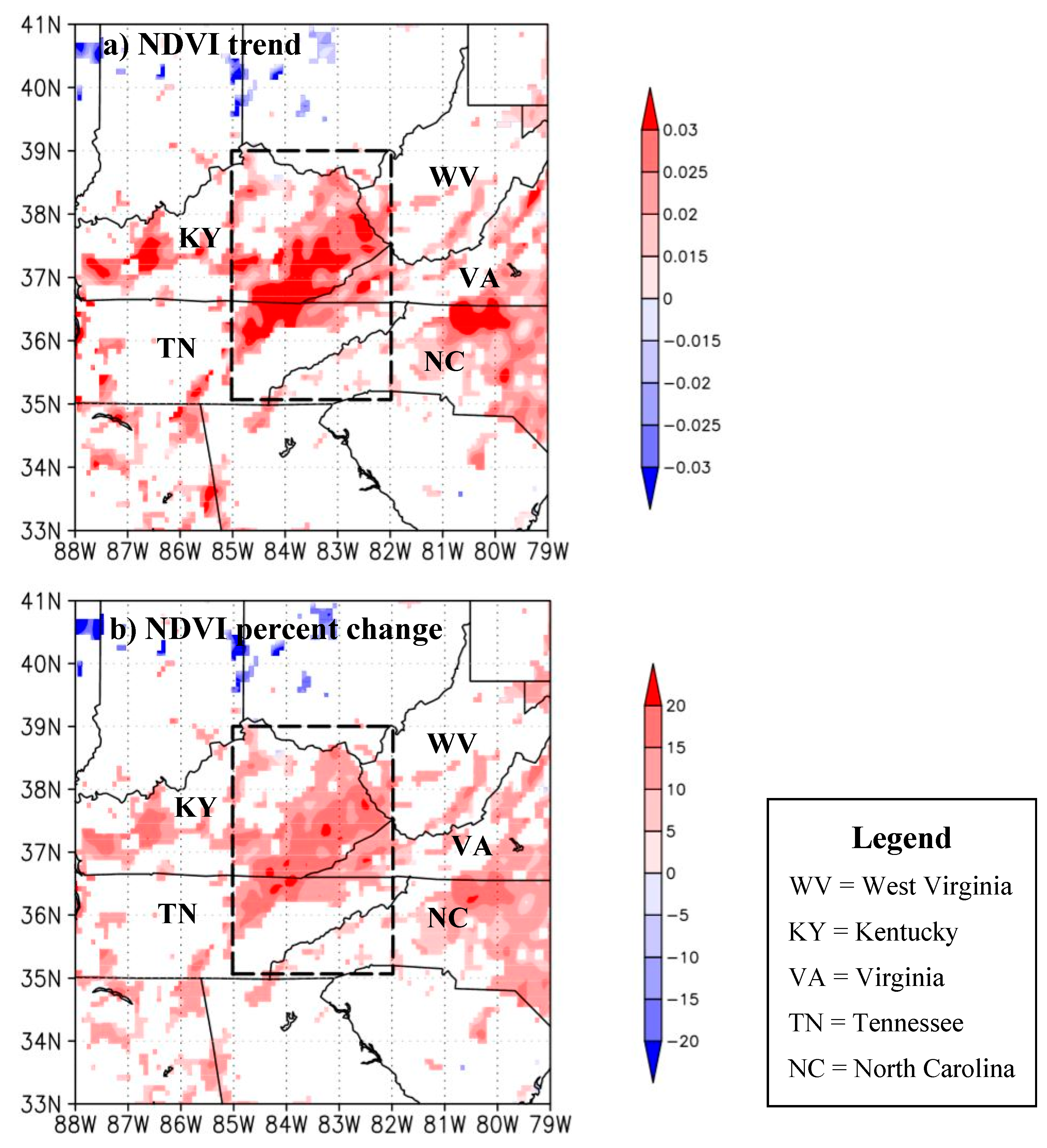

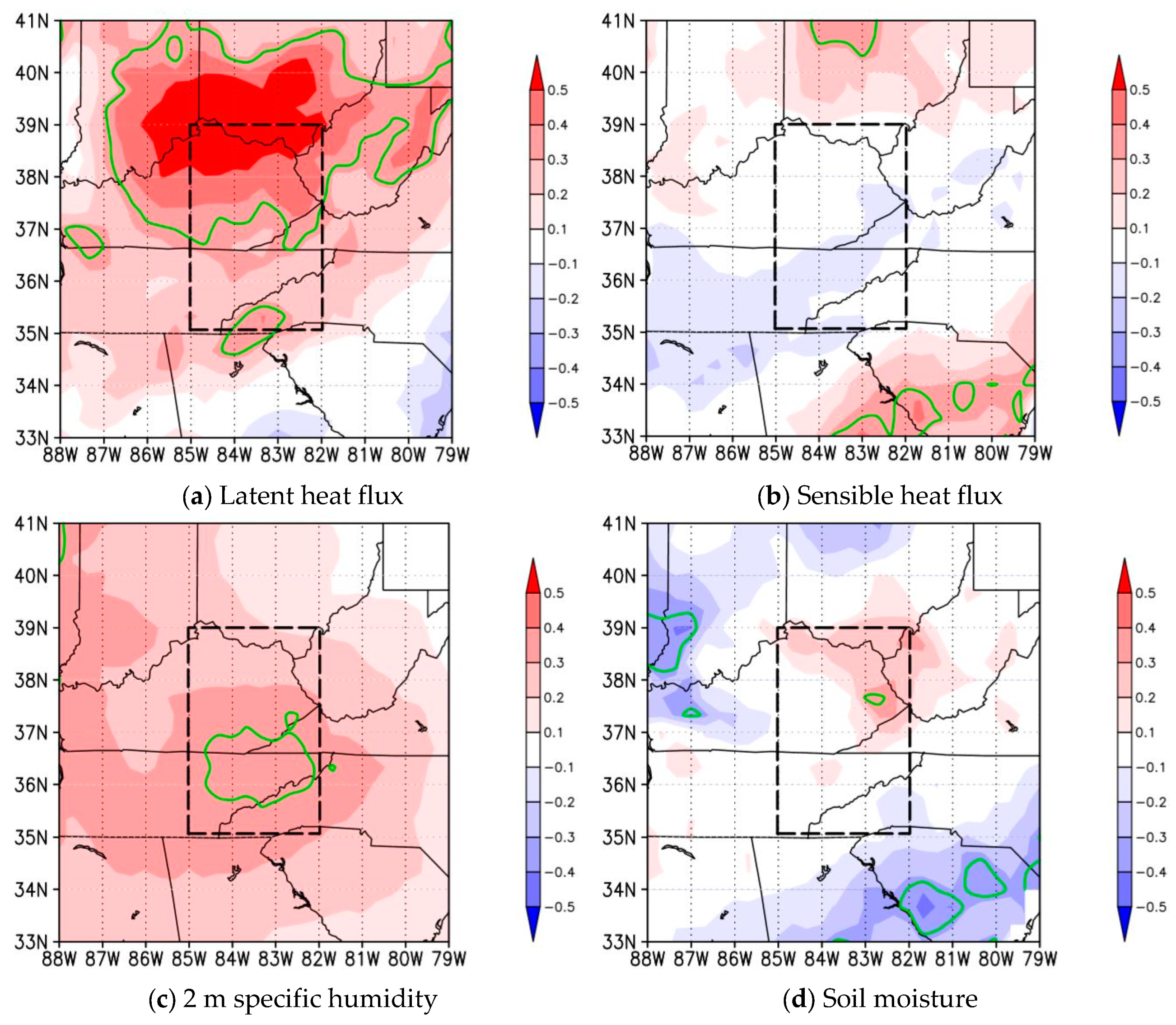
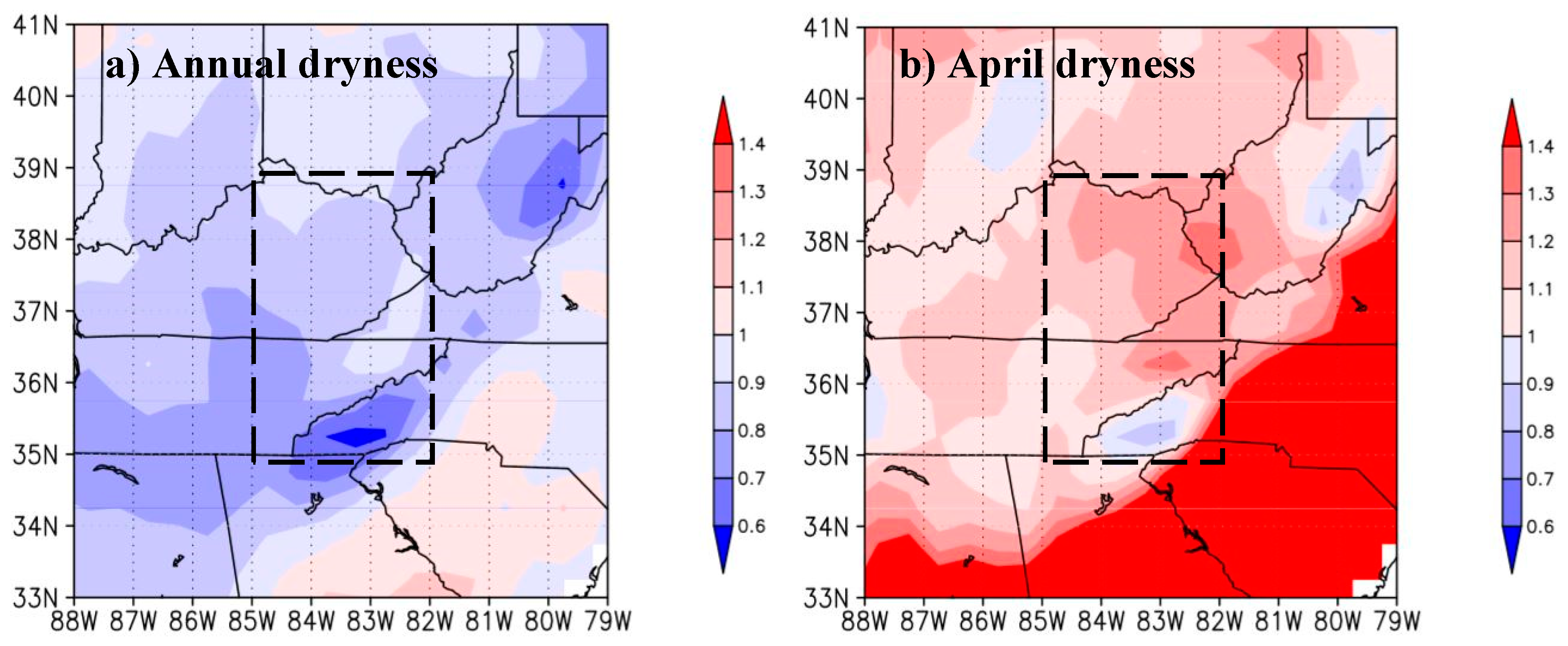
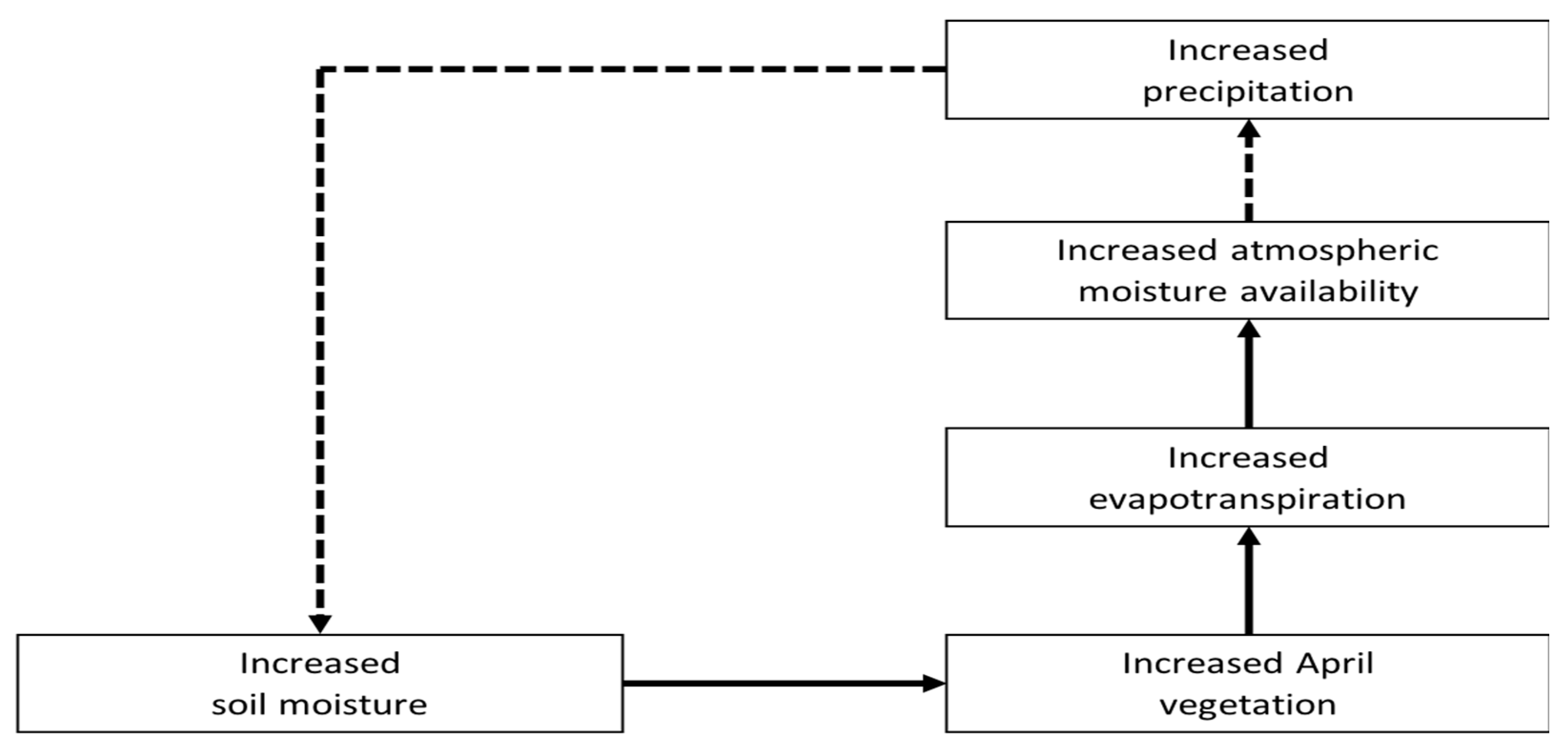
© 2019 by the authors. Licensee MDPI, Basel, Switzerland. This article is an open access article distributed under the terms and conditions of the Creative Commons Attribution (CC BY) license (http://creativecommons.org/licenses/by/4.0/).
Share and Cite
Shull, N.; Lee, E. April Vegetation Dynamics and Forest–Climate Interactions in Central Appalachia. Atmosphere 2019, 10, 765. https://doi.org/10.3390/atmos10120765
Shull N, Lee E. April Vegetation Dynamics and Forest–Climate Interactions in Central Appalachia. Atmosphere. 2019; 10(12):765. https://doi.org/10.3390/atmos10120765
Chicago/Turabian StyleShull, Nathan, and Eungul Lee. 2019. "April Vegetation Dynamics and Forest–Climate Interactions in Central Appalachia" Atmosphere 10, no. 12: 765. https://doi.org/10.3390/atmos10120765
APA StyleShull, N., & Lee, E. (2019). April Vegetation Dynamics and Forest–Climate Interactions in Central Appalachia. Atmosphere, 10(12), 765. https://doi.org/10.3390/atmos10120765





